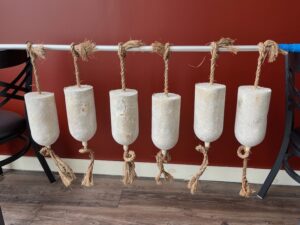Who is a member?
Our members are the local governments of Massachusetts and their elected and appointed leadership.

Nantucket is testing new mushroom-based buoys this summer as an environmentally friendly alternative to the traditional plastic foam buoys the town has used. (Photo courtesy Sue Van Hook/MycoBuoys)
This summer, two harbors in Nantucket will serve as a laboratory for testing new environmentally friendly buoys made from mushrooms.
As part of its shellfish research program, Nantucket’s Natural Resources Department is deploying about 135 new buoys made of mycelium, which is the rootlike structure of a mushroom, and testing their performance against the town’s traditional plastic foam buoys.
A company named MycoBuoys is supplying the new buoys, which this summer will comprise the majority of the 150 total buoys it uses for its scallop research.
The test reflects Nantucket’s willingness to experiment with natural approaches that better protect its harbors, according to Tara Riley, the town’s shellfish and aquatic resources manager.
“Nantucket prides itself on being progressive with some of these initiatives,” Riley said. “We’re always trying to convince the community to make better choices for the environment, and I think as a town leading by example, it’s the right thing to do.”
The buoys will keep afloat the spat lines that the town uses in the water to measure scallop activity from June through October. Held up by three buoys apiece, each line contains five mesh spat bags, which scallop larvae enter and attach to a hard surface inside. The scallops eventually grow too big to swim out, and Nantucket employees collect the bags every six weeks and process them back at the hatchery, counting and measuring the scallops and then relocating them to areas in the harbors where they can thrive and reproduce.
Nantucket is seeking a viable alternative to traditional plastic foam buoys, which degrade over time, depositing carcinogenic microplastics into the water and threatening the health of waterways, marine life and people.
MycoBuoys come in a range of shapes and colors, but Nantucket is getting bullet-shaped buoys, some uncoated, and others coated with 100% natural soy-based paint, according to MycoBuoys founder Sue Van Hook. She and her team grow the buoys in soda bottles, a process that takes five to seven days, she said. Then, they pop them out of the bottles and give them another week to form their skins, before drying them and painting them, she said.
Van Hook said the mycelium buoys should last throughout Nantucket’s entire scallop season, and can later be composted. She hopes her buoys capture the imagination of the island this summer.
“I figure this is going to be the cocktail party conversation of the summer in Nantucket,” Van Hook said.
Nantucket said it is still working out the financial arrangement with Van Hook and figuring out potential future costs if the test goes well. Given the buoys’ labor-intensive manufacturing process, Van Hook said she is still working to reduce the per-buoy cost, and has been in touch with an English collaborator seeking to bring the cost down to $7 to $10 each.
Plastic foam buoys last a long time, but they require maintenance. After every season, Riley said, town employees must remove barnacles and other material from the buoys, pressure wash them, and replace the paint that chips off in the process. So she’s rooting for the mushroom experiment to work.
“It would make us feel a lot better about, you know, our contribution to the harbor while we’re doing research to make the harbor better,” Riley said. “This is the kind of thing that our community can really get behind. They just really love this sort of stuff.”